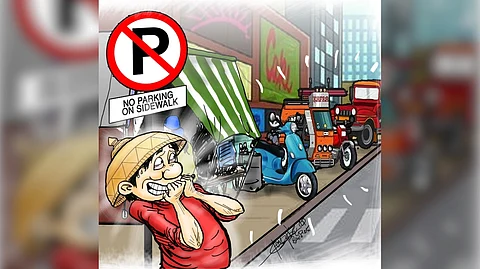
- NEWS
- the EDIT
- COMMENTARY
- BUSINESS
- LIFE
- SHOW
- ACTION
- GLOBAL GOALS
- SNAPS
- DYARYO TIRADA
- MORE

Many Filipino motorists have proven for years what may be impossible for their Japanese counterparts: they can park without actually having anywhere to park their vehicles. How’s that for quirky logic? This reality has ignited many a neighborhood fight, with vehicles blocking driveways even in posh Metro Manila villages and clogging main roads at night.
Going by the suggestion of some commuter advocates, motorists without access to parking spaces should not park anywhere at all. But is a blanket ban the answer? Interior Secretary Jonvic Remulla has proposed a sweeping ban on street parking from 5 a.m. to 10 p.m., with the Metropolitan Manila Development Authority offering its usual half-measures.
The mayors, led by the more practical ones, aren’t too thrilled. Why? Because they know, from years of walking in rubber slippers and not just riding in air-conditioned convoys, that people live on these streets. And many of them have cars, like it or not.
For a large portion of the middle class, parking on the street is the only option. Until we’ve built enough public parking or made commuting as seamless as a Shinkansen ride, we are merely criminalizing this compromise.
Admit it or not, it’s true: parking on public roads clogs traffic, blocks emergency vehicles like ambulances and fire trucks, and reinforces the illusion that owning a car is everyone’s birthright.
Just the same, we can’t ignore the fact that the problem isn’t just about discipline — it’s about infrastructure. The real solution isn’t a sweeping, impractical ban, but a granular, oversight-driven approach that balances the needs of motorists with the public good.
Local governments do have a point. They must be allowed to exercise discretion. Not every barangay is created equal. The alleyways of San Juan are not the wide boulevards of Quezon City. A granular approach, as Remulla himself conceded, is the saner route. Let LGUs decide — within reason — where to allow night parking and where to strictly enforce bans.
Still, let’s not pretend all LGUs are paragons of good judgment. We’ve all seen it: barangay officials turning entire stretches of public roads into private garages, complete with cones, chains, and faded tarpaulin signs claiming “No Parking–Barangay Use.” This is a blatant abuse of autonomy that we must guard against.
There is a lesson to be learned from Japan. Before you can buy a car there, you must prove you have a parking space — not necessarily owned, but at least rented and accessible.
This simple requirement imposes order before chaos can even begin. No parking, no car. While perhaps too effective for our taste, the proof-of-parking idea is a principle we should consider: that the privilege of owning a car comes with the responsibility of securing a place to park it.
Until then, we must find a balance. Let LGUs do their job — with oversight. Let them determine which roads can serve as lifelines for people who have nowhere else to leave their vehicles.
But let us draw a line, beyond which “public road” no longer means “private garage.” That balance — between compassion and control — is where true governance lives and, okay, parks.
